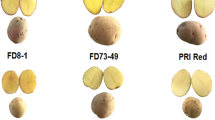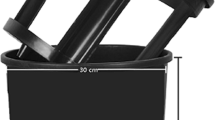Summary
This literature review shows general agreement on rapid respiration immediately after harvest, particularly in immature tubers, followed by a fall, in 3–6 weeks, to 3–8 mg kg−1 h−1. Evidence is conflicting on whether respiration is then constant or continues to fall slowly until the rise accompanying sprout growth; and on the effects of tuber size and of cultivar, particularly in relation to maturity type. Chemical treatments to stimulate sprouting increase respiration, possibly because of tissue damage. Chemical sprout suppressants prevent the rise in respiration accompanying sprout growth. Sudden temperature change and injury temporarily increase respiration. Potassium status influences respiration, possibly because of effects on damage susceptibility.
Zusammenfassung
-
1.
Unmittelbar nach der Ernte war die Atmungsaktivität sehr hoch, vor allem wenn die Knollen unreif geerntet worden waren. Innerhalb von 3–6 Wochen sank sie auf einen relativ konstanten Wert ab. sogar bei hoher Temperatur.
-
2.
Während der Hauptlagerungsperiode betrug die Atmungsrate 3–8 mg CO2 pro kg und Stunde bei den meisten Lagerungstemperaturen. Es gab beträchtliche Unterschiede zwischen den Ergebnissen verschiedener Autoren, abhängig von der Sorte, der Jahreszeit, der Keimungsrate und anderen Faktoren.
-
3.
Ein plötzlicher Anstieg der Lagertemperatur führte zu einer Steigerung der Atmungsrate über der von Kartoffeln, die ständig bei hoher Temperatur gelagert worden waren: aber nach einer kurzen Periode fiel sie wieder auf den gleichen Wert ab. Ein plötzlicher Temperaturabfall führte ebenfalls zu einem zeitlich begrenzten Atmungsanstieg.
-
4.
Im allgemeinen scheint die Atmungsrate während der Lagerung bis zu einem Minimum abzusinken, gefolgt von einem Atmungsanstieg. der besonders ausgeprägt zu Beginn der Keimung war. Dieser allgemeine Verlauf kann jedoch durch kurzfristige Änderungen der Atmungsaktivität überlagert werden.
-
5.
Die Atmungsrate war ein charakteristisches Merkmal der Sorte. Versuchsergebnisse über einen möglichen Zusammenhang zwischen einer frühen Reifezeit einer Sorte und ihrer Atmungsaktivität während der Lagerung waren widerspruchsvoll. Zwischen der Länge der Keimruhe von Sorten und ihrer Atmungsaktivität während dieser Periode wurde keine Verbindung gefunden.
-
6.
Eine Verletzung der Knollen führte ebenso wie eine Behandlung mit Chemikalien zu einem starken Anstieg der Atmung. Dieser, durch Chemikalien hervorgerufene Anstieg, kann cher auf einen Verletzungseffekt als auf einen direkten Einfluss der Chemikalien auf den Atmungsprozess zurückgeführt werden. Ausnahmen von dieser Regel waren bestimmte Keimhemmungsmittel, Wuchsstoffe und Alkohole.
-
7.
Der Einfluss der Umweltbedingungen während des Knollenwachstums auf die Atmungsrate nach der Ernte wurde nicht in grossem Umfang untersucht. Die Versorgung mit Kalium kann vielleicht die Atmung beeinflussen, aber das erfolgt eher über den Einfluss auf die Beschädigungsempfindlichkeit des Gewebes als durch eine direkte Beeinflussung der Atmung selbst.
-
8.
Obwohl ein Zusammenhang zwischen der Knollengrösse und der Atmungsrate bestand, waren die Daten zu ungenügend, um zu erklären, wie der Einfluss der Knollengrösse ausgeschaltet werden kann.
Résumé
-
1.
L'activité respiratoire immédiatement après la récolte est très élevée particulièrement si les tubercules ont été arrachés avant maturité. Elle tombe à un niveau relativement constant au cours des trois à six semaines qui suivent, même si la température est élevée.
-
2.
Durant la conservation, l'intensité respiratoire est de l'ordre de 3 à 8 mg CO2 kg−1 h−1 pour la plupart des températures de stockage mais ces chiffres varient considérablement selon les auteurs et dépendent de la variété, de l'époque, du degré de germination et probablement d'autres facteurs.
-
3.
Des élévations rapides de température accélèrent davantage la respiration qu'une température plus élevée maintenue constante. Mais ce phénomène diminue après une courte période. Une chute rapide de température peut aussi provoquer une activation temporaire de la respiration.
-
4.
Il semble qu'en cours de conservation, l'intensité respiratoire diminue progressivement puis qu'elle augmente à nouveau, particulièrement au départ de la germination. Cependant, ce phénomène peut être masqué par des fluctuations dans l'activité respiratoire.
-
5.
L'intensité respiratoire est une caractéristique variétale. Les données expérimentales concernant une éventuelle relation entre la précocité d'une variété et son activité respiratoire en cours de conservation sont contradictoires. Aucune relation n'a été trouvée entre la durée du repos végétatif et l'intensité respiratoire des variétés durant cette période.
-
6.
Les endommagements des tubercules provoquent un accroissement marqué de la respiration qui survient également si les tubercules sont traités chimiquement. Dans ce dernier cas, l'effet phytotoxique peut être mis en cause plutôt qu'une influence directe sur le processus respiratoire. Les inhibiteurs chimiques, les régulateurs de croissance, les alcools font exception à cette règle.
-
7.
L'influence des conditions de végétation sur l'intensité respiratoire des tubercules après la récolte n'a pas fait l'objet de recherches importantes. Le potassium apporté peut influencer l'activité respiratoire mais plutôt parce qu'il modifie la sensibilité des tissus aux endommagements que par une action directe sur la respiration.
-
8.
Bien qu'il y ait une relation entre le calibre et la respiration, les données sont insuffisantes pour déterminer comment cette influence du calibre peut être éliminéc.
Similar content being viewed by others
References
Appleman, C. O. & E. V. Miller, 1926. A chemical and physiological study of maturity in potatoes.J. Agric. Res. 33: 569–577.
Appleman, C. O., W. D. Kimbrough & C. L. Smith, 1928. Physiological shrinkage of potatoes in storage.Univ. Maryland Agric. Exp. Stn. Bull. 303.
Appleman, C. O. & C. L. Smith, 1936. Effect of previous cold storage on the respiration of vegetables at higher temperatures.J. Agric. Res. 53: 557–580.
Barker, J., 1933a. Analytic studies in plant respiration. IV, Part I. The effect of temperature-history on the respiration sugar relation.Proc. Roy. Soc. Lond. B 112: 316–335.
Barker, J., 1933b. Analytic studies in plant respiration. IV, Part II. The form of the normal respiration/sugar relation and the mechanism of depression.Proc. Roy. Soc. Lond. B. 112: 336–358.
Barker, J., 1935. A note on the effect of handling on the respiration of potatoes.New Phytol. 34: 407–408.
Barker, J., 1938. Changes of sugar-content and respiration in potatoes stored at different temperatures.Rep. Fd Invest. Board for 1937: 175–177.
Baumeister, W., 1948. Über die Atmung verschiedener Kartoffelsorten in Abhängigkeit von den Klima- und Bodenverhältnissen der Anbaugebiete.Planta 36: 214–229.
Boe, A. A., G. W. Woodbury & T. S. Lee, 1974. Respiration studies on Russet Burbank potato tubers: Effects of storage temperature and chemical treatments.Am. Potato J. 51: 355–360.
Burton, W. G., 1952. Studies on the dormancy and sprouting of Potatoes III. The effect upon sprouting of volatile metabolic products other than carbon dioxide.New Phytol. 51: 154–162.
Burton, W. G., 1962. A simple apparatus for measuring oxygen uptake and carbon dioxide output.Eur. Potato J. 5: 220–227.
Burton, W. G., 1963a. Concepts and mechanisms of dormancy.Proc. 10th Easter Sch. Agric. Sci. Univ. Nott. 1963: 17–41. Published as: J. D. Ivins & F. L. Milthorpe (Ed.), The growth of the potato. Butterworth, London.
Burton, W. G., 1963b. The effect of stage of maturity and storage on the respiratory quotient of potato tubers.Eur. Potato J. 6: 268–270.
Burton, W. G., 1964. The respiration of developing potato tubers.Eur. Potato J. 7: 90–101.
Burton, W. G., 1966. The potato: a survey of its history and of factors influencing its yield, nutritive value, quality and storage. Veenman, Wageningen, Netherlands, 2nd ed., p. 227.
Burton, W. G., 1974. The oxygen uptake, in air and in 5% O2, and the carbon dioxide output of stored potato tubers.Potato Res. 17: 113–137.
Burton, W. G., G. Mann & H. G. Wager, 1955. The storage of ware potatoes in permanent buildings. II. The temperature of unventilated stacks of potatoes.J. agric. Sci. 46: 150–163.
Craft, C. C., 1963. Respiration of potatoes as influenced by previous storage temperature.Am. Potato J. 40: 289–298.
Denny, F. E., 1926a. Hastening the sprouting of dormant potato tubers.Am. J. Bot. 13: 118–125.
Denny, F. E., 1926b. Second report on the use of chemicals for hastening the sprouting of dormant potato tubers.Am. J. Bot. 13: 386–396.
Hanes, C. S. & J. Barker, 1931. The physiological action of cyanide. I. The effects of cyanide on the respiration and sugar content of the potato at 15°C.Proc. Roy. Soc. Lond. B 108: 95–118.
Hopkins, E. F., 1924. Relation of low temperatures to respiration and carbohydrate changes in potato tubers.Bot. Gaz. 78: 311–325.
Huelin, F. E. & J. Barker, 1939. The effect of ethylene on the respiration and carbohydrate metabolism of potatoes.New Phytol. 38: 85–104.
Kimbrough, W. D., 1925. A study of respiration in potatoes with special reference to storage and transportation.Univ. Maryland Agric. Exp. Stn. Bull. 276: 51–72.
Lutman, B. F., 1926. Respiration of potato tubers after injury.Bull. Tottey Bot. Club 53: 429–455.
Mapson, L. W. & W. G. Burton, 1962. The terminal oxidases of the potato tuber.Biochem. J. 82: 19–25.
Meinl, G., 1961. Ein Beitrag zur Atmung von Kartoffelknollen.Flora 150: 493–500.
Meinl, G., 1967. Zur Bezugsgrösse der Respirationsintensität von Kartoffelknollen.Eur. Potato J. 10: 249–256.
Michaels, W. H., 1932. Relation of lenticels and surface area to respiration in the potato tuber.Bot. Gaz. 94: 416–418.
Miller, L. P., 1933a. Effect of sulphur compounds in breaking the dormancy of potato tubers and inducing changes in the enzyme activities of the treated tubers.Contrib. Boyce Thompson Inst. 5: 29–81.
Miller, L. P., 1933b. Effect of various chemicals on the sugar content, respiratory rate and dormancy of potato tubers.Contrib. Boyce Thompson Inst. 5: 213–234.
Miller, L. P., 1934a. Time relations in effect of ethylene chlorhydrin in increasing and of ethyl alcohol in decreasing the respiration of potato tubers.Contrib. Boyce Thompson Inst. 6: 123–128.
Miller, L. P., 1934b. The effect of the alkyl halides on the respiration of potato tubers.Contrib. Boyce Thompson Inst. 6: 279–296.
Miller, L. P., J. D. Guthrie & F. E. Denny, 1936/37. Induced changes in respiration rates and time relations in the changes in internal factors.Contrib. Boyce Thompson Inst. 8: 31–61.
Mulder, E. G., 1955. Effect of mineral nutrition of potato plants on respiration of the tubers.Acta bot. neerl. 4: 429–451.
Nelson, D. C., R. H. Smith, H. J. Klosterman & M. S. Quraishi, 1971. 2,4-D Residues in tubers: texture and respiration of potatoes in storage.Am. Potato J. 48: 366–373.
Paez, L. E. & H. O. Hultin, 1970. Respiration of potato mitochondria and whole tubers and relation to sugar accumulation.J. Fd Sci. 15: 46–51.
Rosa, J. T., 1923. Abbrevation of the dormant period in potato tubers.Proc. Am. Soc. Hort. Sci. 20: 180–187.
Schander, R., E. Profft & P. Münchberg, 1931/32a. Beiträge zur Atmung der Kartoffelknolle. I.Pflanzenbau 8: 1–6.
Schander, R., E. Profft & P. Münchberg, 1931/32b. Beiträge zur Atmung der Kartoffelknolle. II. Einfluss der Temperature auf die Atmungstätigkeit von Kartoffelknolle.Pflanzenbau 8: 121–124.
Schander, R. and E. Profft, 1932/33. Beiträge zur Atmung der Kartoffelknolle. III. Einfluss mechanischer und chemischer Reizung.Pflanzenbau 9: 161–177.
Schulz, K. G., 1926/27. Vergleichende Untersuchungen über die Atmungsvorgänge bei verschiedenen Kartoffelsorten.Landw. VersSt 105: 23–73.
Singh, B. N. & P. B. Mathur, 1938a. Studies in potato storage. II. Influence of (1) the stage of maturity of the tubers and (2) the storage temperature for a brief duration immediately after digging on physiological losses in weight of potatoes during storage.Ann. appl. Biol. 25: 68–78.
Singh, B. N. & P. B. Mathur, 1938b. Studies in potato storage. III. Respiration of potatoes during storage.Ann. appl. Biol. 25: 79–87.
Smith, O., 1929. Effects of various treatments on the carbon dioxide and oxygen in dormant potato tubers.Hilgardia 4: 283–306.
Smith, O., 1933. Studies of potato storage.Cornell Univ. agric. Exp. Stn Bull. 553.
Weber-Dahlmann, M., 1957. Beiträge zur Einwirkung organisch chemischer Substanzen auf die Lagerfähigkeit von Kartoffeln.Z. Bot. 45: 395–420.
Ziegenbein, E., 1893. Untersuchungen über den Stoffwechsel und die Athmung keimender Kartoffelknollen sowie anderer Pflanzen.Jb. Wiss. Bot. 25: 563–606.
Author information
Authors and Affiliations
Rights and permissions
About this article
Cite this article
Schippers, P.A. The rate of respiration of potato tubers during storage 1. Review of literature. Potato Res 20, 173–188 (1977). https://doi.org/10.1007/BF02360280
Accepted:
Issue Date:
DOI: https://doi.org/10.1007/BF02360280




